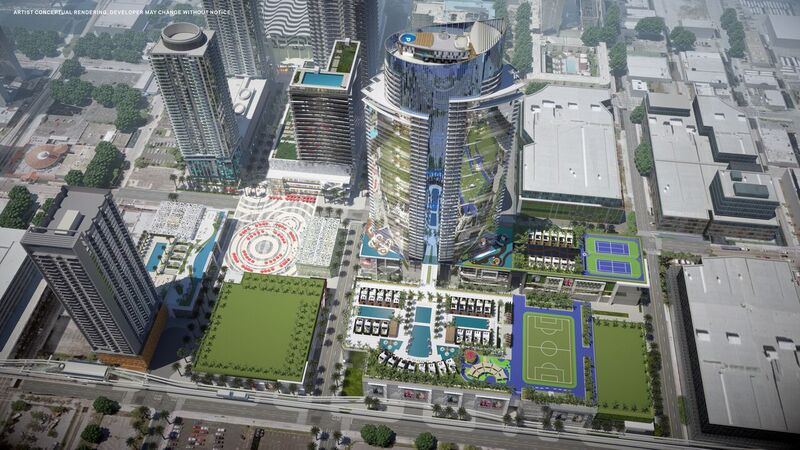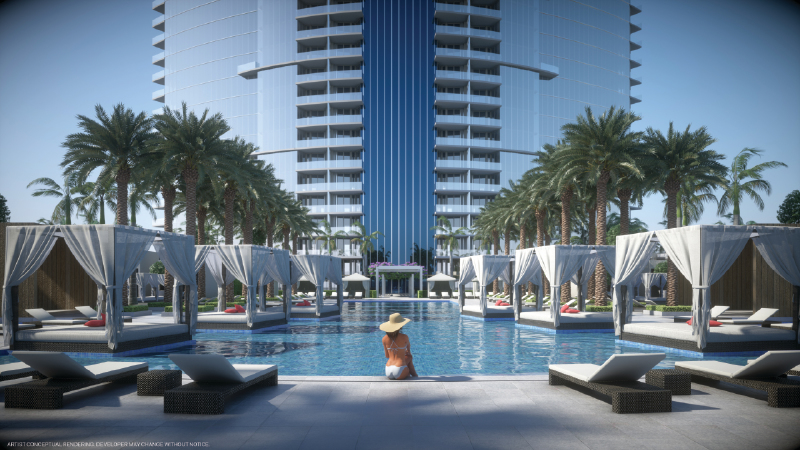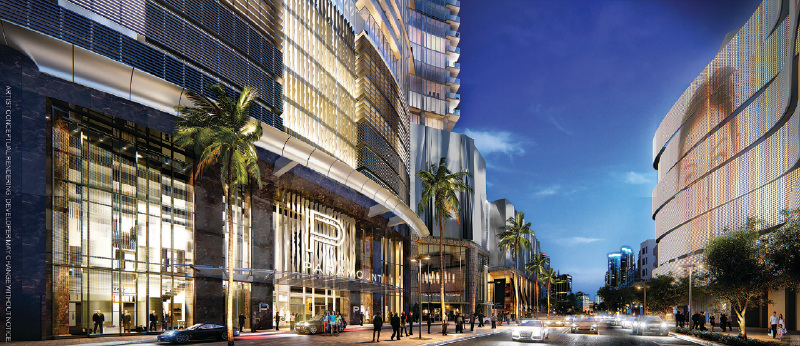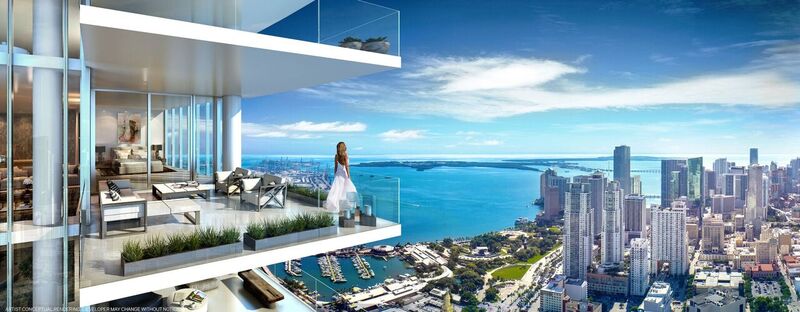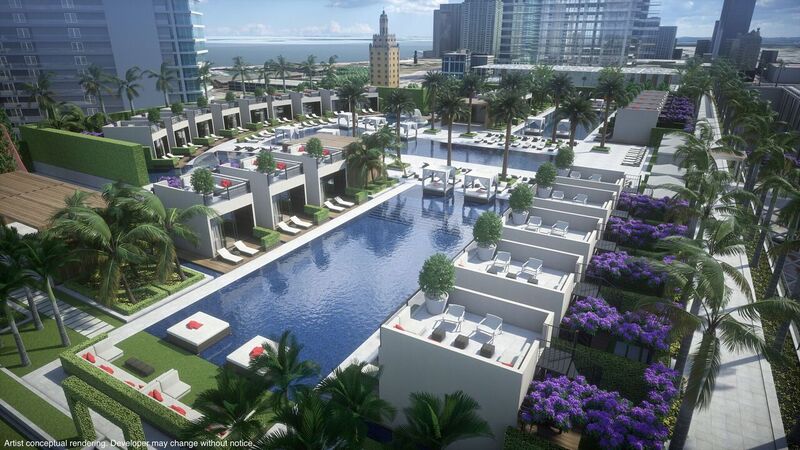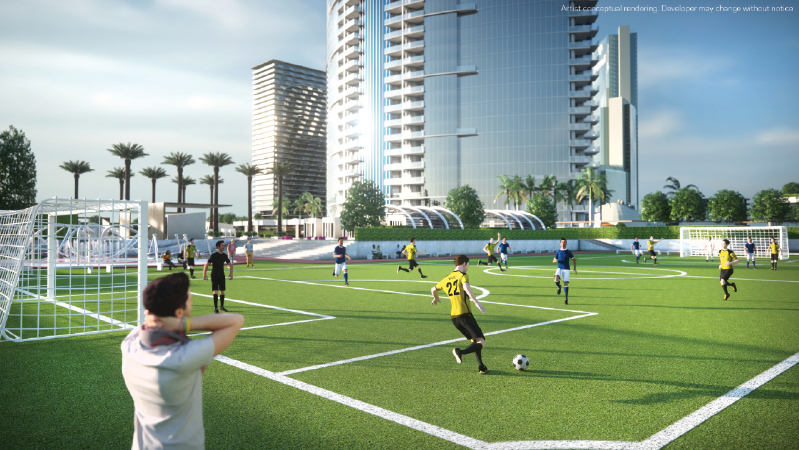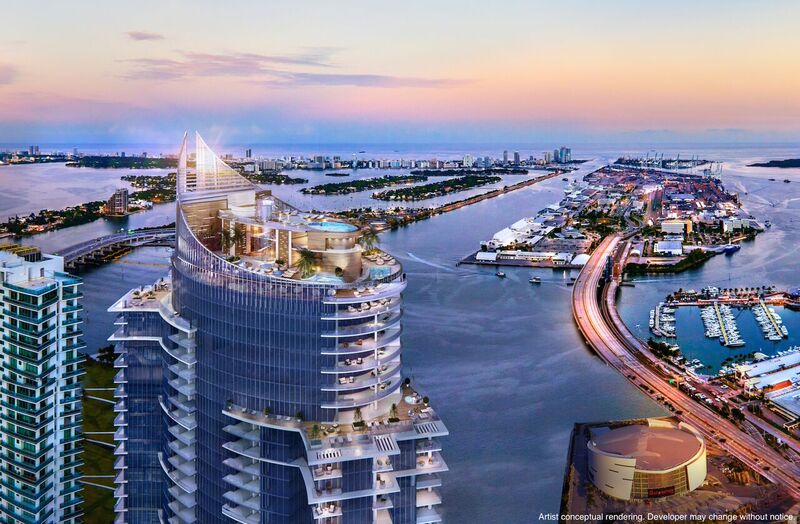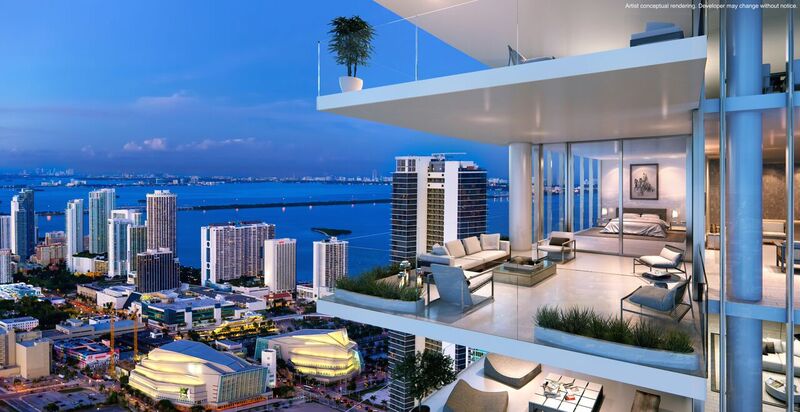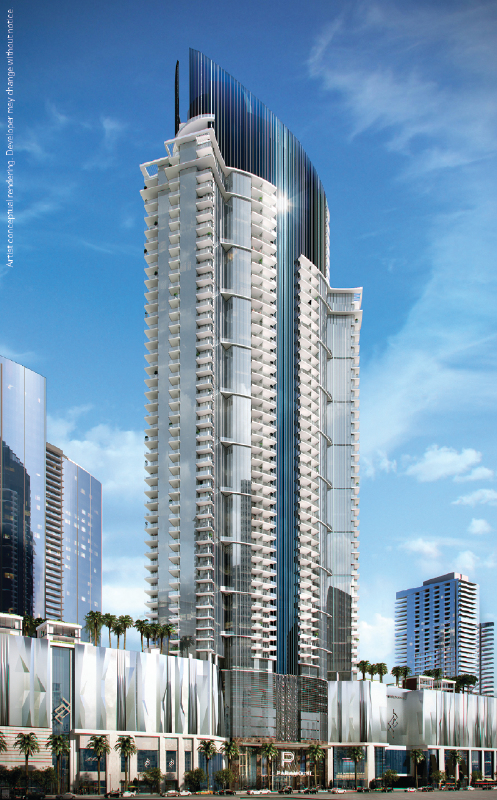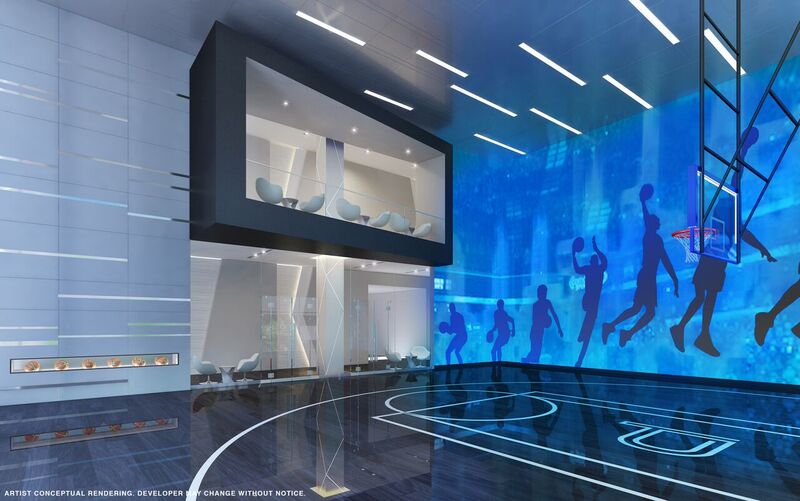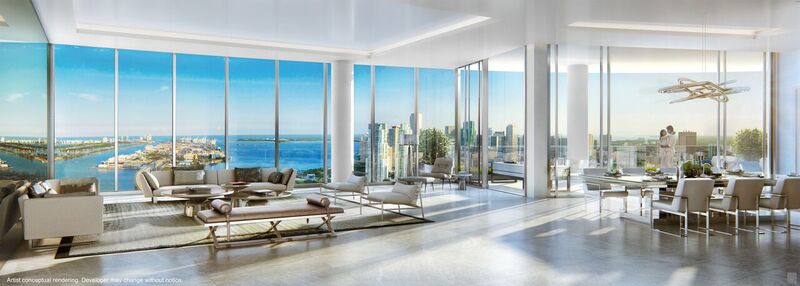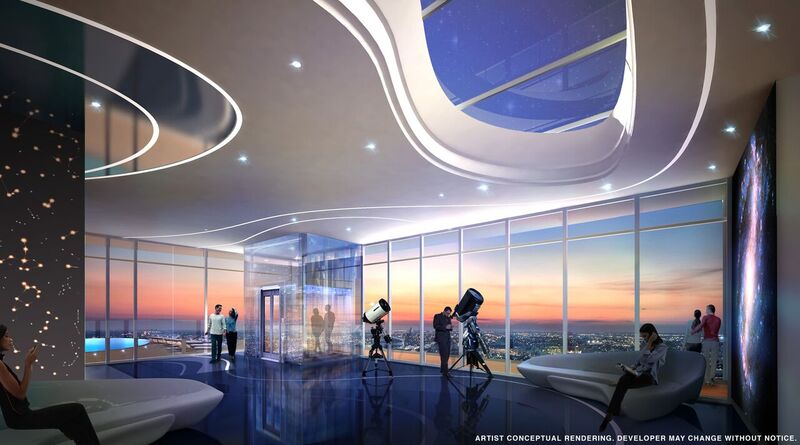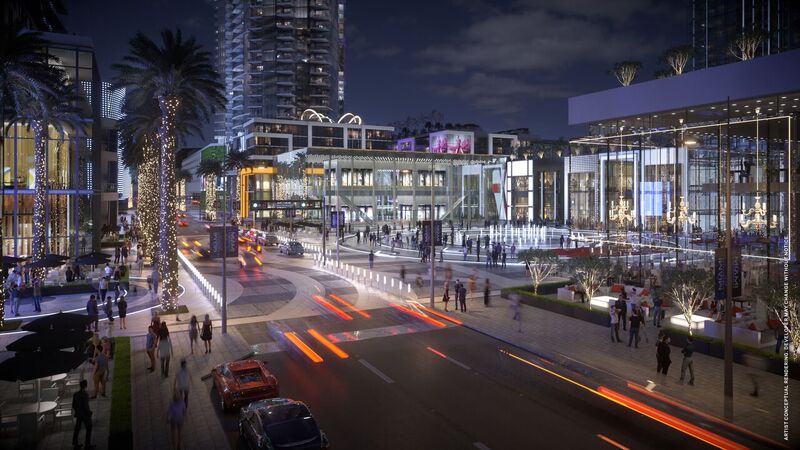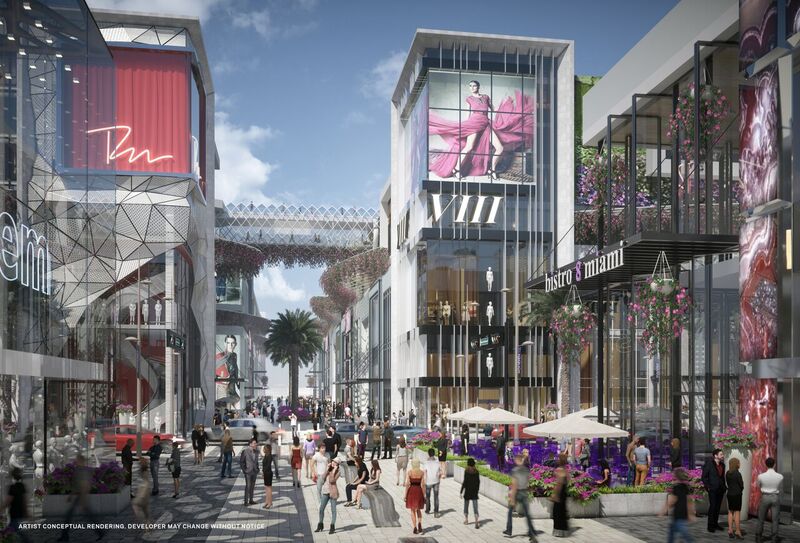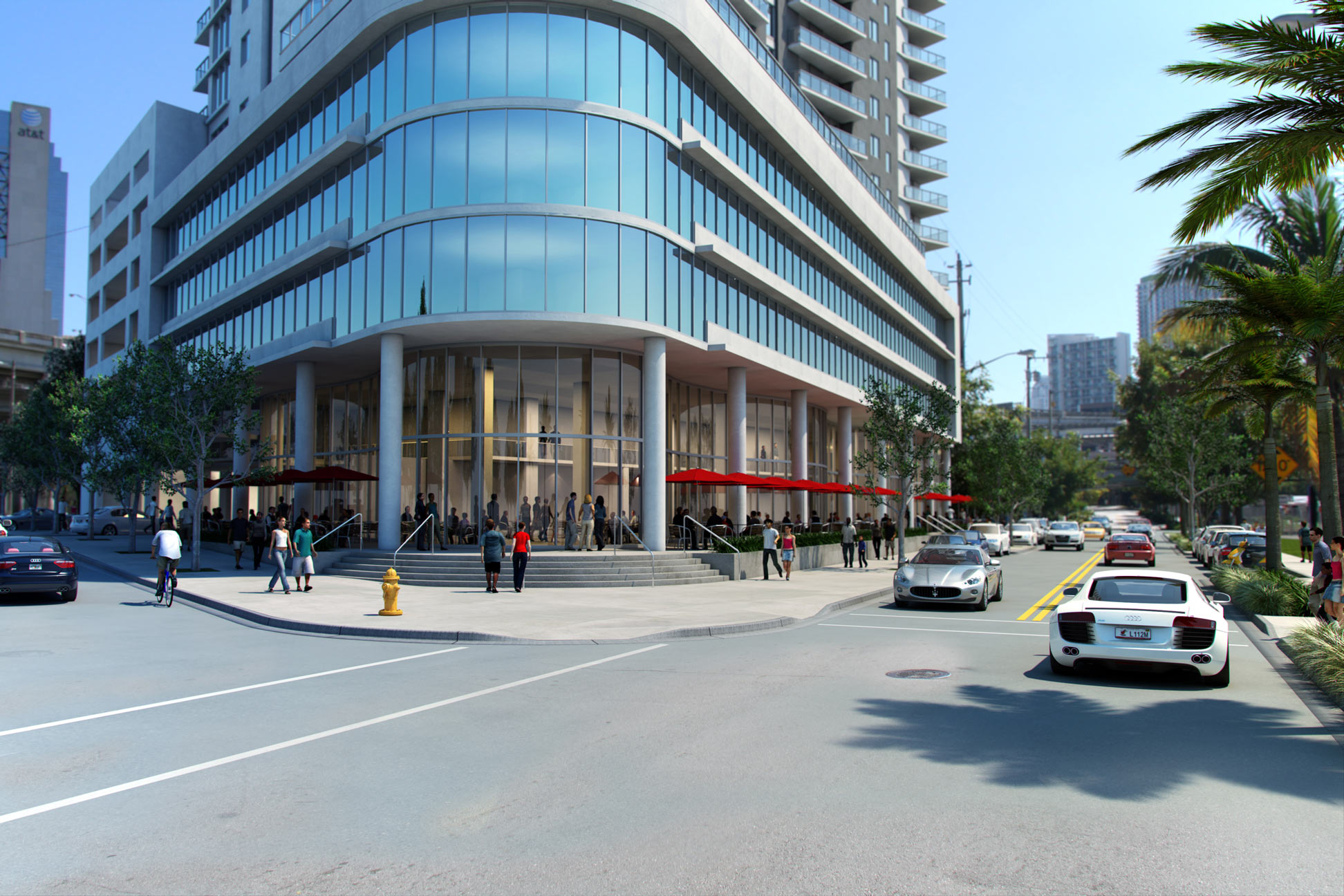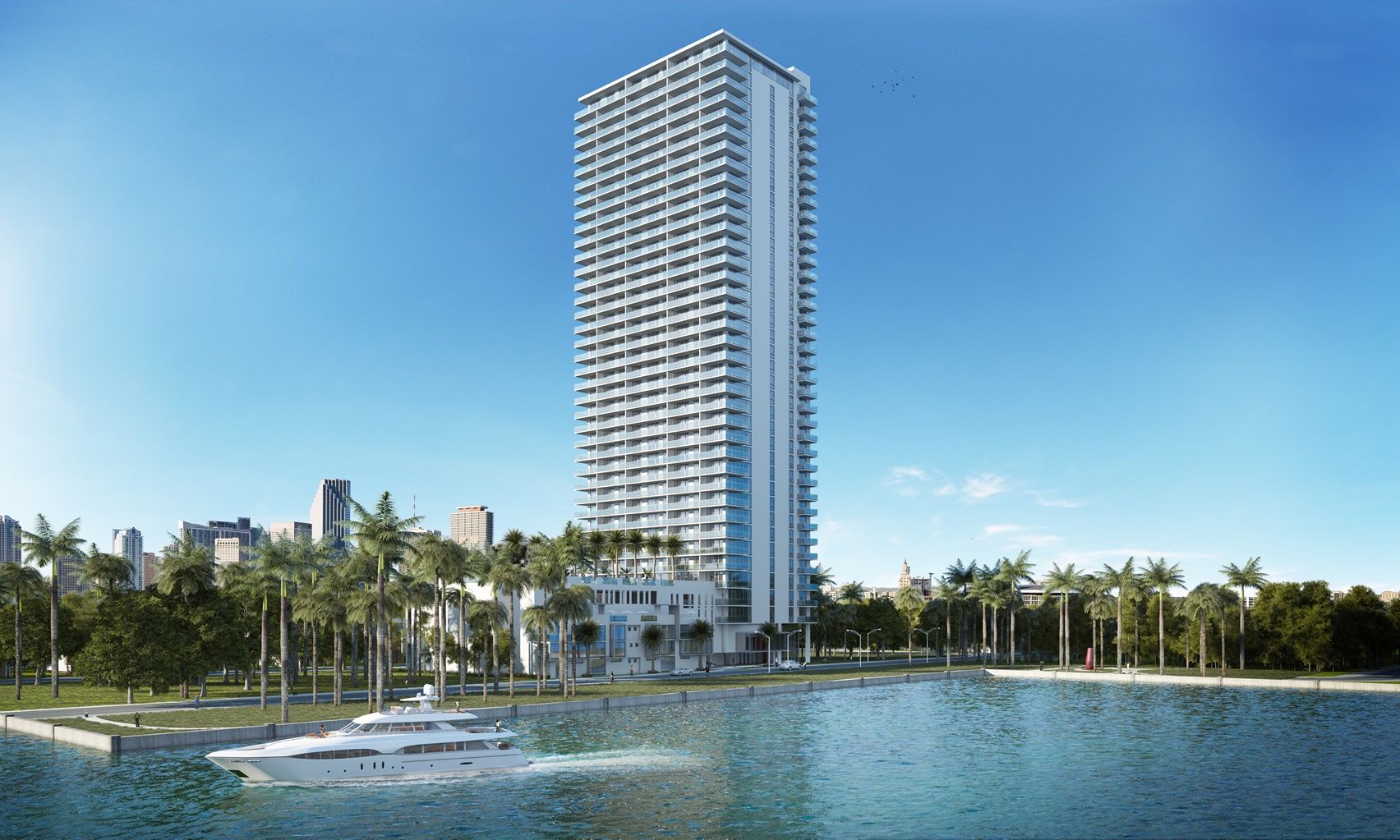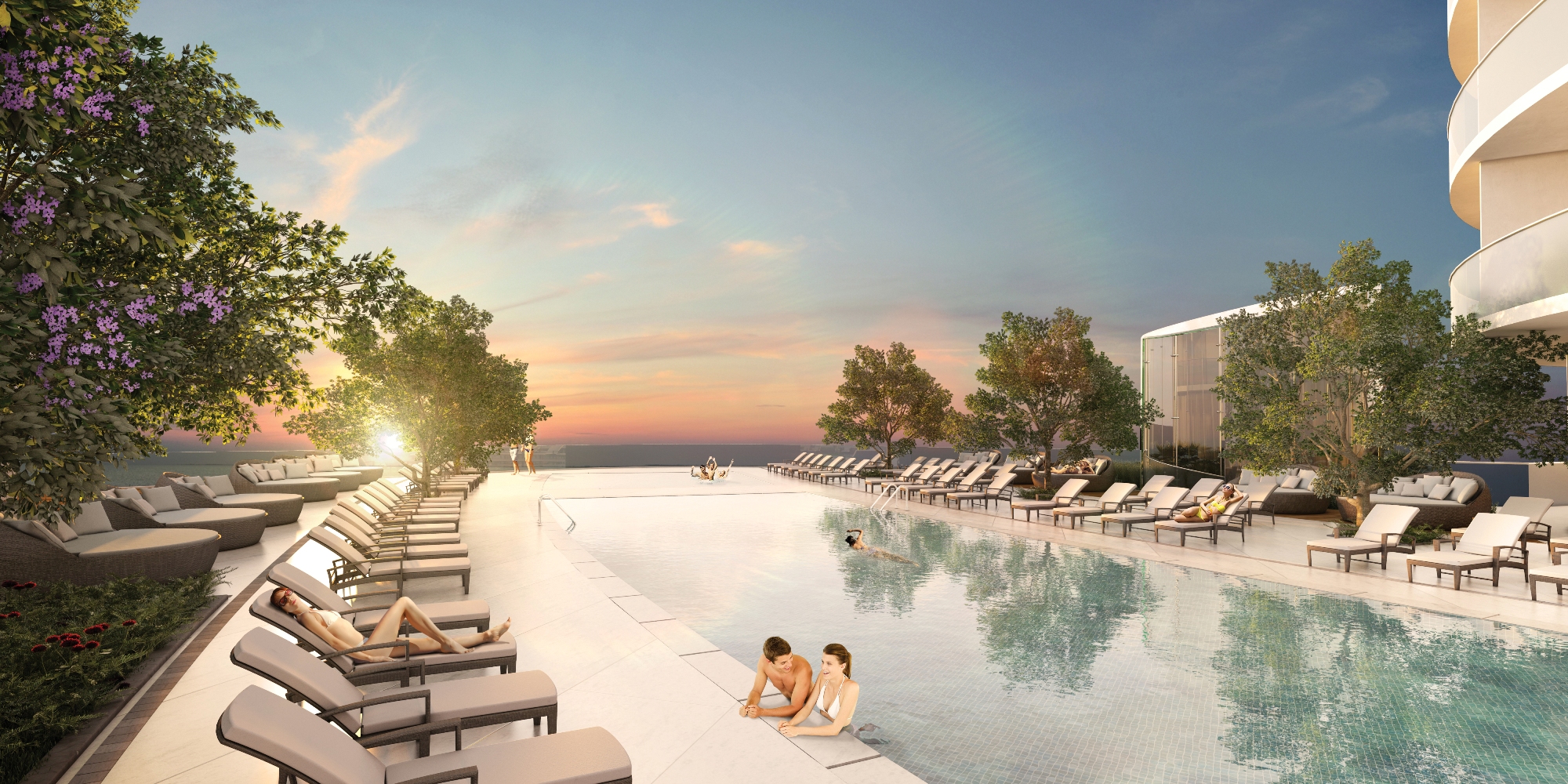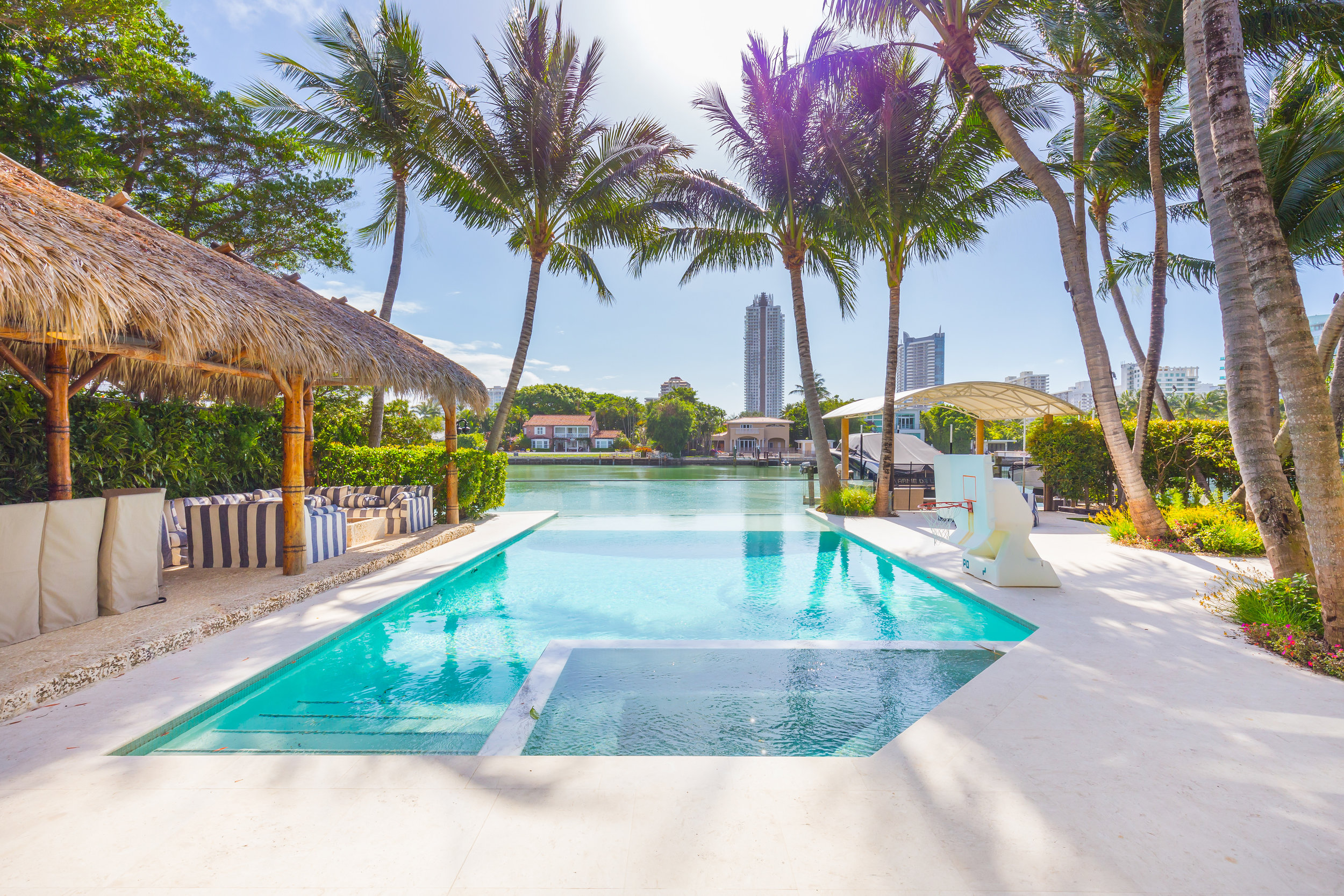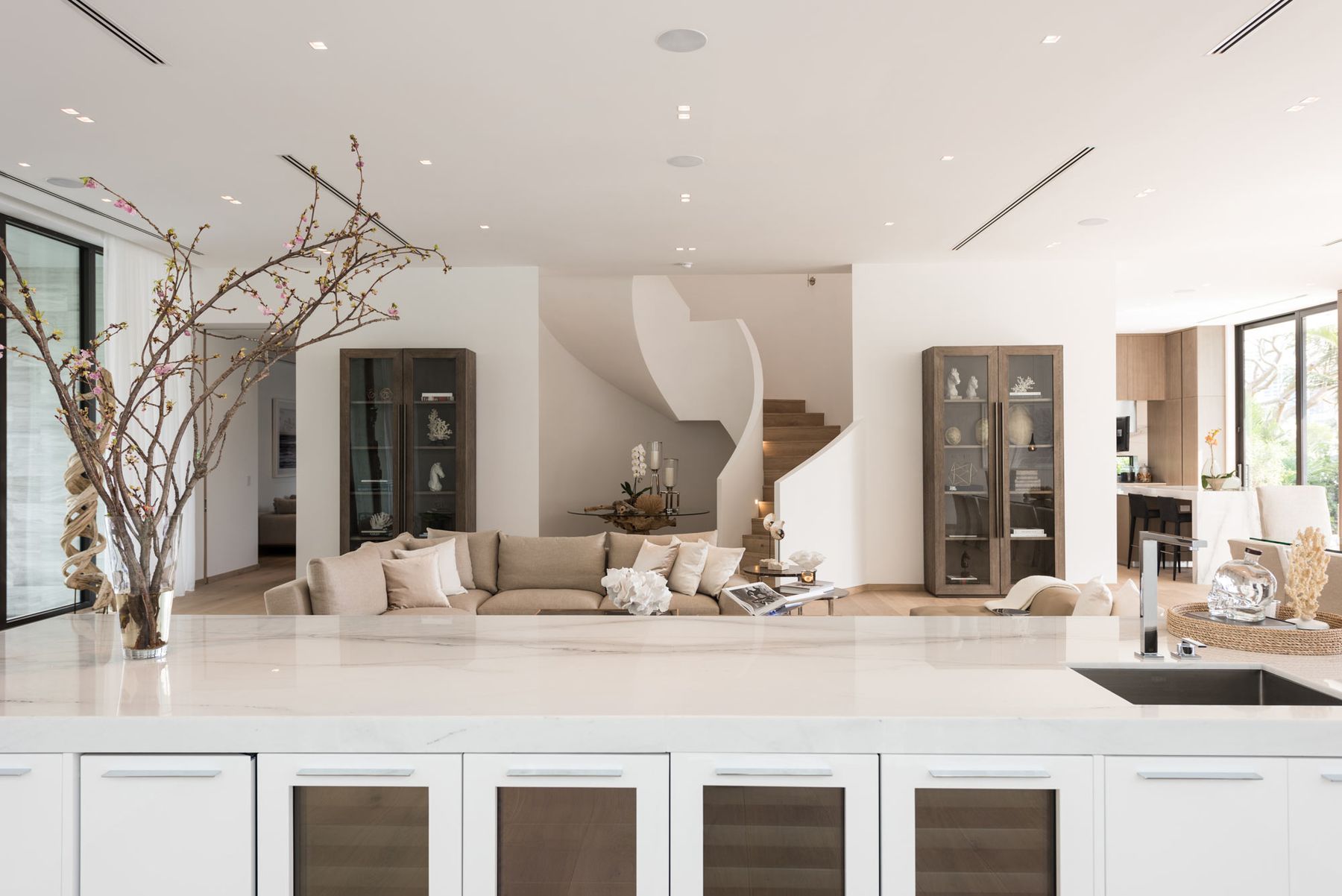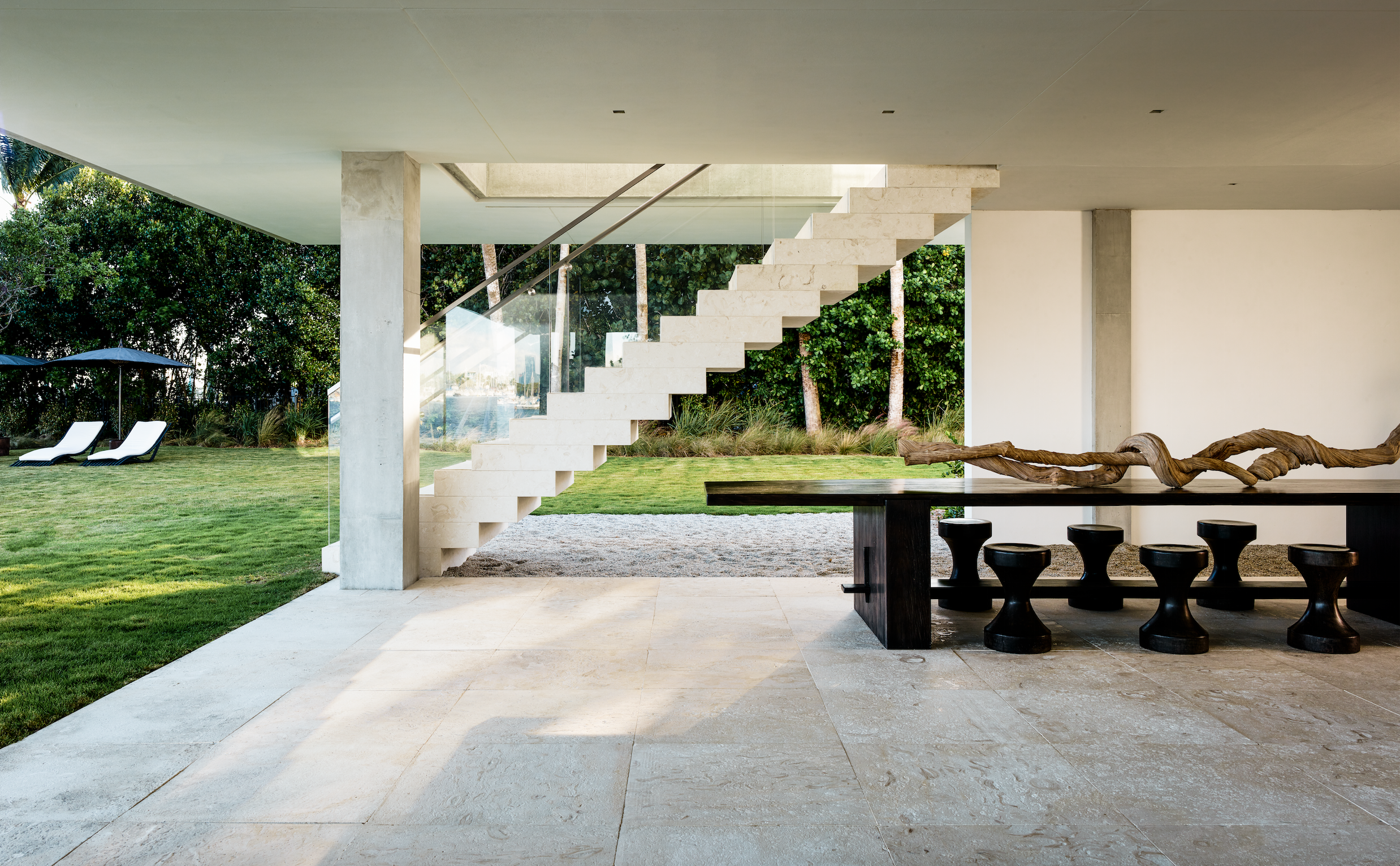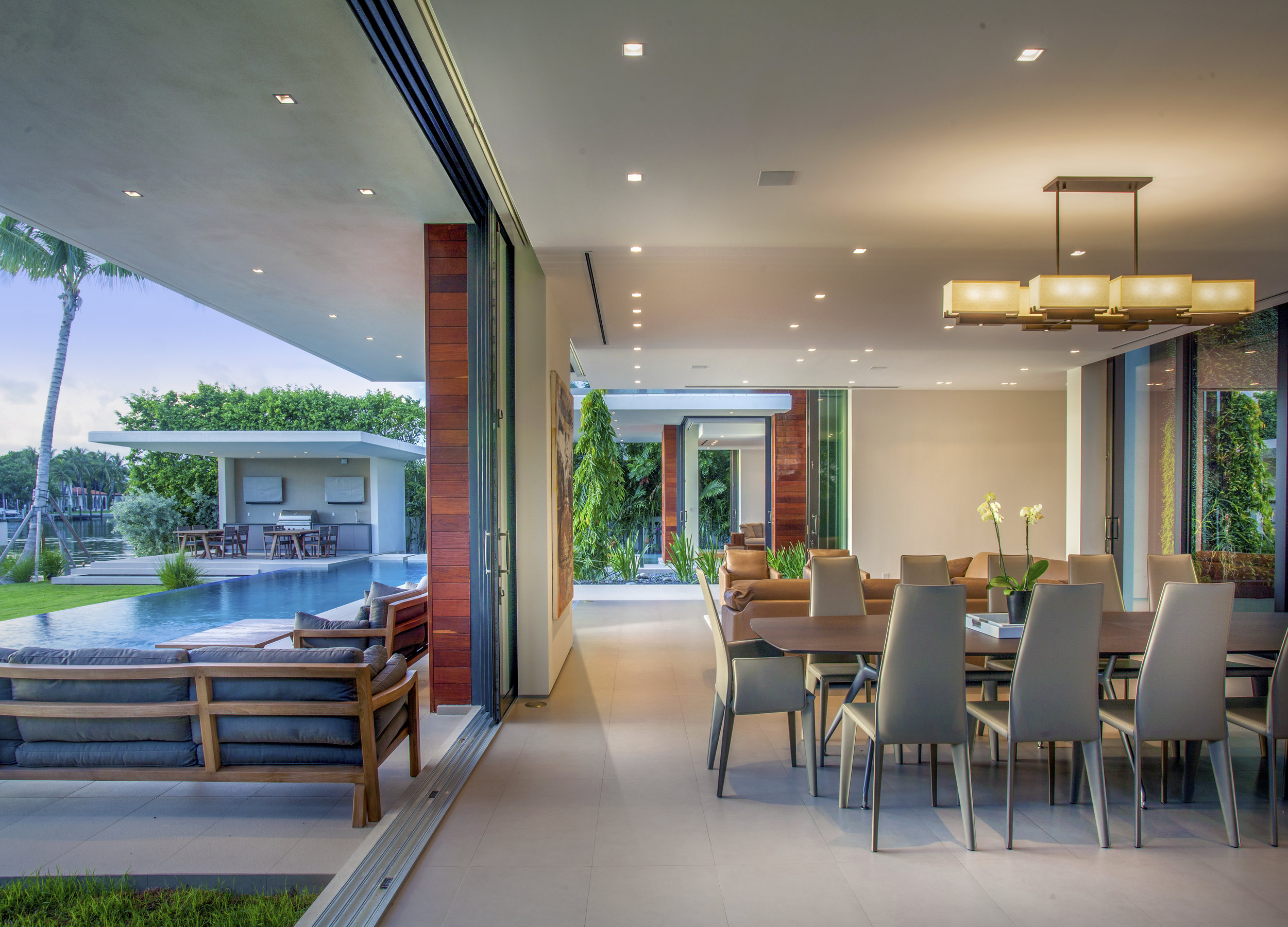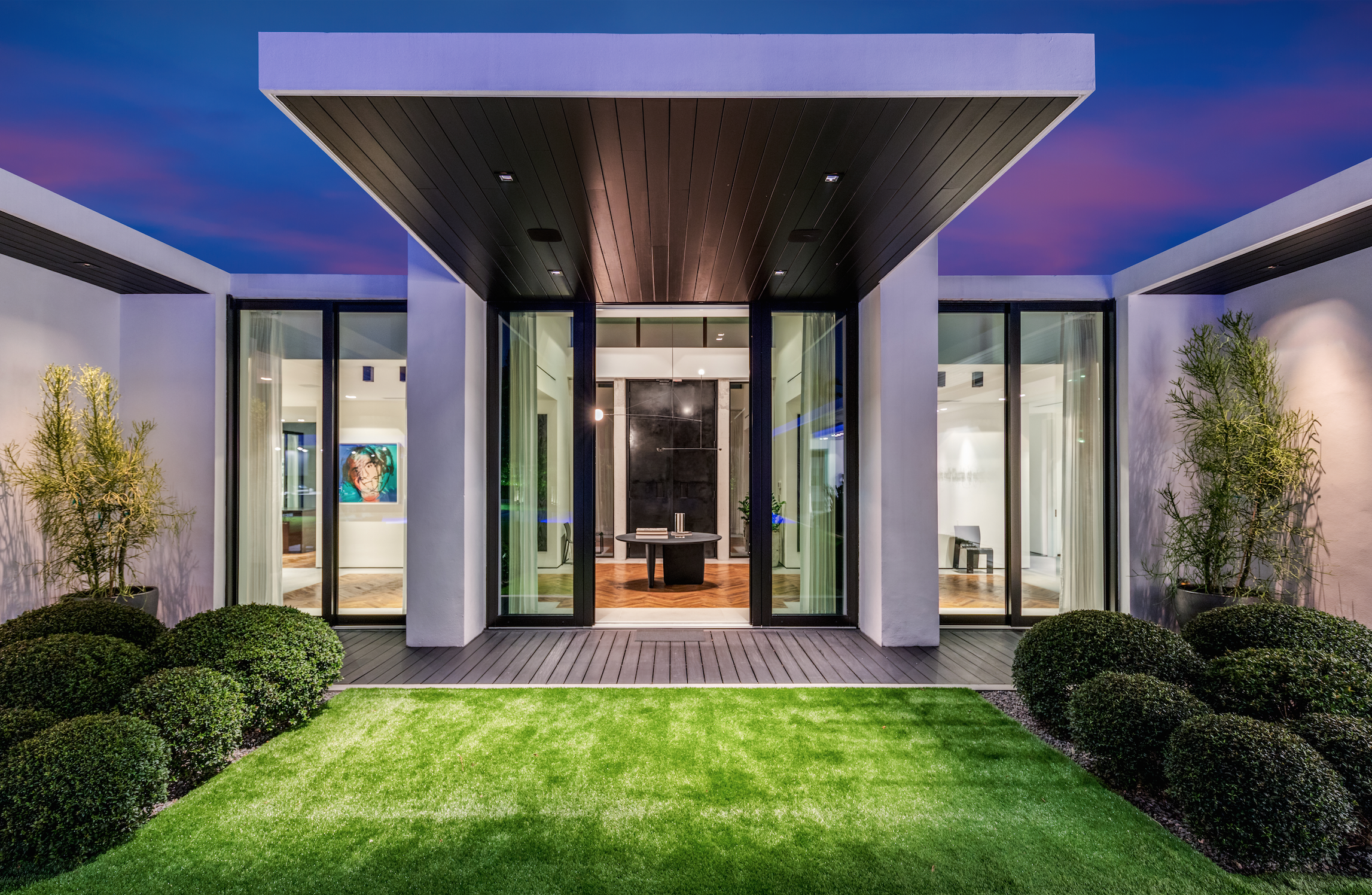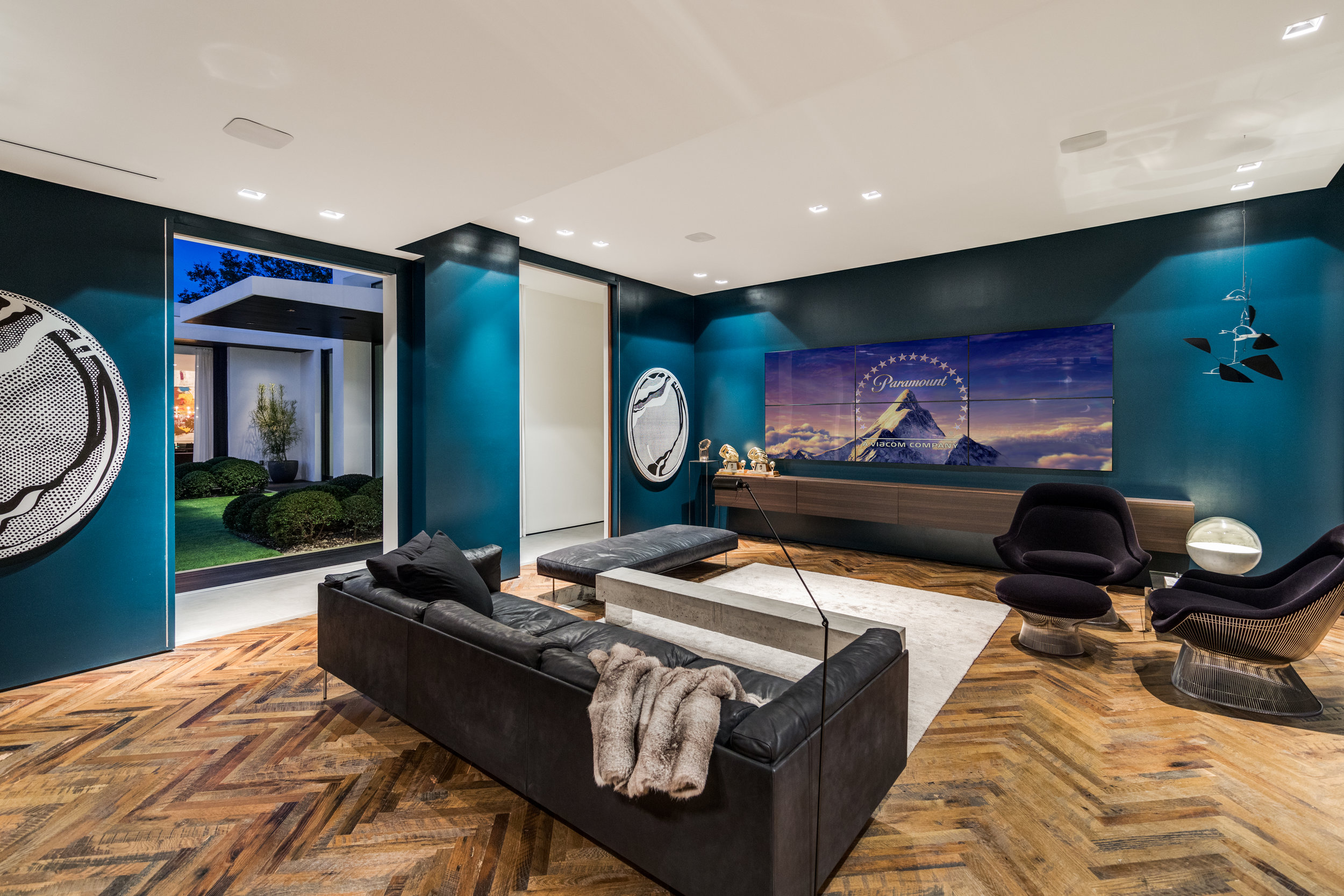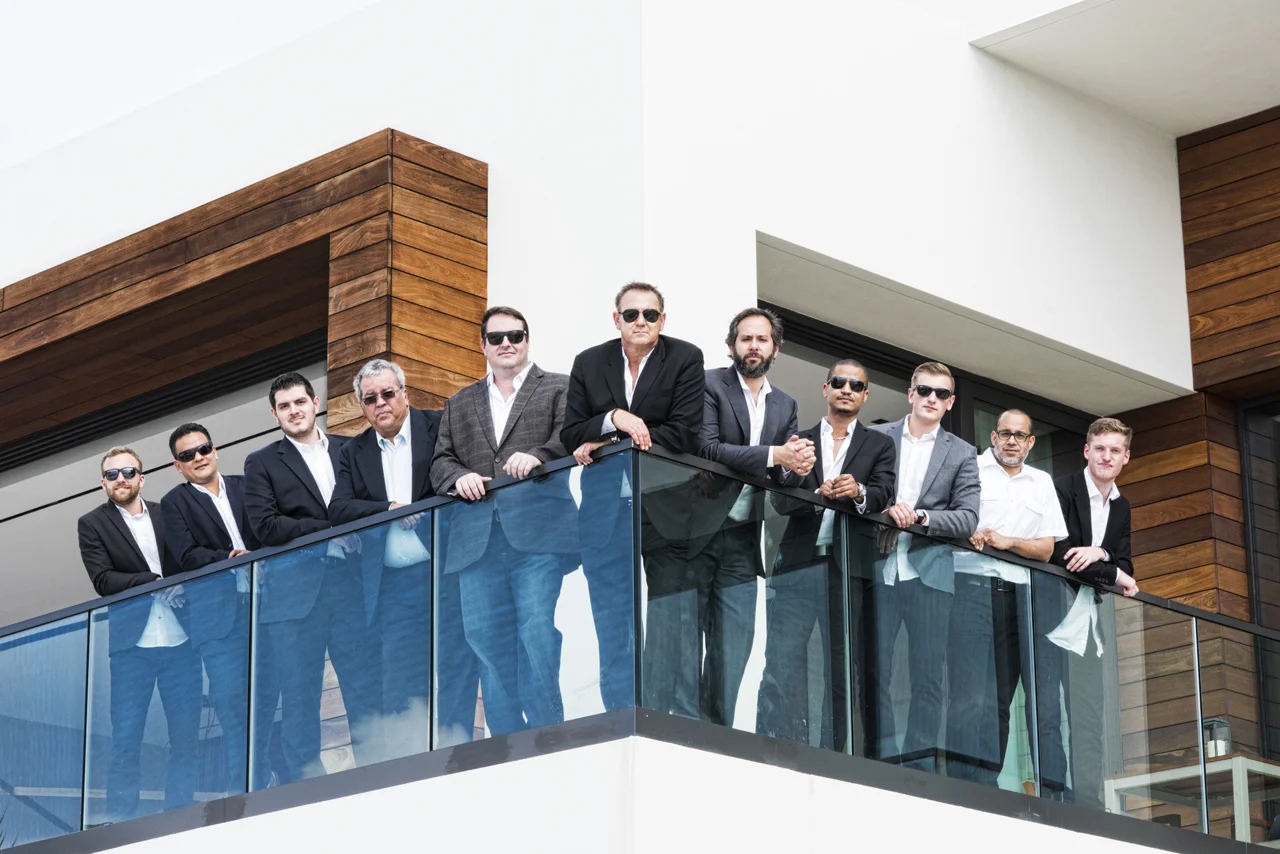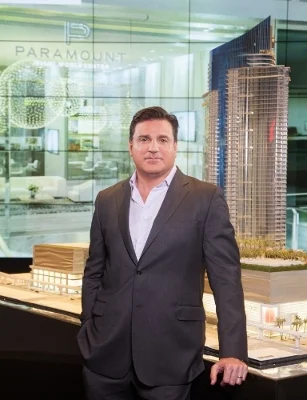Casa Bahia, a hyper-luxurious tropical contemporary located at 3085 Munroe Drive designed by Zyscovich Architects in partnership with filmmaker Alejandro Landes, has sold for $45.91 million in an off-market transaction.
Read MorePROFILE Exclusive: How the Melo Group Took Edgewater Real Estate to the Next Level with Aria on the Bay
PROFILEmiami had the exclusive opportunity to sit down with Carlos and Martin Melo, founders and principals of The Melo Group, as well as tour their brand-new luxury condo development on North Bayshore Drive, Aria on the Bay. Their multi-generational family business is thriving as they continue to deliver projects across all neighborhoods and price points as their vision continues to drive the city of Miami forward. Find out how they brought Aria on the Bay from concept to reality in just a few short years.
PM: The lot that Aria on the Bay now stands on was such a prime lot on a road with major residential demand, how did you guys get access to such a great lot/ opportunity?
MM: We bought this land about nine years and what we found was a beautiful land in a premier location, so we held on to it until we decided that it was the proper time to develop it. It was also the last piece of land in front of the park and in front of the water. We worked on the design for some years and then we decided it was the moment to start!
PM: How did the concept for Aria on the Bay come about? What was your main goal with the project?
MM: Our main goal was to build a spectacular building, in an extraordinary location with amazing views. It’s situated in downtown Miami’s burgeoning Arts & Entertainment District, which is home to some of South Florida’s top destinations for arts and culture, entertainment, dining and shopping. It’s one block from Venetian Causeway, one block from 395 and it’s very close to the airport, Downtown, the Metromover, Adrienne Arsht Center, the museums, and the arena.
When you live in a crowded city like New York or Buenos Aires, you really know what the location and views mean. We’ve seen the transformation of the city in the last 15 years, and knew that this was a prime location. You have to select what is the best place to build if you are a developer, or to buy if you are a buyer.
PM: What do you think of the recent new developments in Edgewater and the new energy they have brought to the area?
CM: The recent new developments are extremely nice and have changed the area. I think that people now realize the value of the Edgewater location and are starting to see the neighborhood come alive. Residents of all these new buildings and Aria on the Bay will live within blocks of world-class venues such as the Adrienne Arsht Center for the Performing Arts, Museum Park’s Perez Art Museum Miami, the Patricia and Phillip Frost Museum of Science, and the American Airlines Arena.
Also, nearby are dozens of luxury retail shops and restaurants in the Miami Design District, Midtown Miami, Brickell City Centre, and the upcoming Miami Worldcenter project. Several public transit and alternative transportation options are within walking distance, with trips to South Beach and the Brickell Financial District only a few minutes away.
The area is new and it is up-and-coming. We are creating a new building that will be part of a new kind of neighborhood that will fulfill necessities for the modern lifestyle and what is coming in the future.
PM: Edgewater has seen some great towers be built in recent years. What sets Aria on the Bay apart from these other developments? What makes it so unique?
CM: It’s the last one to be built in front of the park, and we have a price point that is extremely reasonable for the high-end product we are delivering. We were able to have this price point because we got a good value on the land, when we bought it years ago, before anyone knew what Edgewater was.
We are also a vertically-integrated firm, meaning we handle everything in-house because it allows us to have complete control of our projects – from the design process to the development/construction phase – we typically act as our own architects, general contractors, property managers and developers. The system has worked very well for us over the years, allowing us to complete our projects on time and within budget, control construction costs and move on to the next project ahead of the real estate cycle.
All of the decisions are made by my father, my brother and myself. All of this allows us to reduce the price and give a better product at the best price for our buyers.
PM: What is the best feature that residents will enjoy?
MM: They will be impressed with the units because they are very well designed. Units feature floor-to-ceiling glass, expansive wrap-around terraces, private elevator access, open-plan living areas, designer finishes and fixtures, European-style kitchens, and modern custom-designed cabinetry.
We also have a 14th floor resort amenity deck with two sunrise/sunset-facing swimming pools, a jacuzzi, custom-seated fire pits, barbecue grills and outdoor summer kitchens. Additional perks include a private spa with massage treatment facilities, a state-of-the-art fitness center, yoga studio, entertainment lounge, and a screening room.
Our location can’t get any better- Aria on the Bay overlooks Margaret Pace Park giving residents access to a host of additional amenities and activities. Situated directly along Biscayne Bay, the 8-acre, the pet-friendly waterfront park offers jogging paths, biking trails, tennis courts, basketball courts, soccer fields, an outdoor gym, daily yoga and fitness classes, as well as barbecue areas, picnic and playground areas.
PM: What will Aria on the Bay mean to Edgewater in the short & long term?
CM: For Miami, it adds value-the beautiful architecture and design of the tower, are the creation of internationally-acclaimed design firm Arquitectonica. We had buyers from 42 different countries making it a very international tower, continuing to position Miami as an international destination and hub.
In the past, when immigrants arrived in the U.S. they would often all choose to live in one neighborhood, where they could feel a piece of their homeland by sharing with other immigrants from the same county. Nowadays, Miami has become so multi-cultural that wherever you go, you feel the urge to want to be interconnected with different cultures and dive into the energetic vibes the city gives off as a whole. The world is moving towards one community and both Miami and this building are a great example of this!
PM: Where do you see Edgewater's place in Miami in the next 5 to 10 years?
MM: I think it will be an extremely desirable residential area in the next 5 to 10 years. Edgewater is an option for residents who want to get away from downtown Miami’s traffic congestion, yet want to live in the urban core. If you want to work in Downtown you can walk to the Metromover and in two minutes be in Downtown. With its waterfront location, luxury buildings and pedestrian-friendly setting in the center of Miami’s thriving urban core, Edgewater is one of the best value-buys in all of South Florida.
About The Melo Group:
The Melo Group was originally founded in 1948 by Armando Ferreira de Melo in Buenos Aires, Argentina, the Melo Group is one of the strongest family-owned, full-service real estate development firms operating in South Florida today. To date they are behind more than 50 successfully completed projects which offer a combined total of more than 5,000 residential units. The company also remains actively involved in real estate development in Argentina as well as in Montevideo, Punta del Este, Uruguay. Dr. Jose Luis Ferreira de Melo acts as the President and managerial leader of the company along with his sons, Mr. Carlos Ferreira de Melo and Mr. Martin Ferreira de Melo. Their contributions to Miami include Aria on the Bay, Bay House Miami, Flagler on the River, and Melody amongst others.
About Aria on the Bay:
Aria on the Bay is a luxury condo development located on the coveted North Bayshore Drive in Edgewater. Units at Aria on the Bay range from 1 to 4 bedrooms and $400K to $6 million and sold around $550 per square foot. Residences feature floor-to-ceiling glass, expansive wrap-around terraces, private elevator access, open-plan living areas, designer finishes and fixtures, European-style kitchens, and modern custom-designed cabinetry. Amenities include a 14th floor resort amenity deck with 2 sunrise/sunset swimming pools, a jacuzzi, custom-seated fire pits, barbecue grills and outdoor summer kitchens, a private spa with massage treatment facilities, a state-of-the-art fitness center, yoga studio, entertainment lounge, and a screening room. More than 80 percent of the units at Aria on the Bay have been sold. For more information about Aria on the Bay, please contact Cervera Real Estate at (305) 537-0666 or visit the project’s sales gallery at 250 NE 25th Street, Suite 101, Miami, FL 33137. Learn more at www.ariaonthebay.com.
Featured Listing: Pine Tree Drive Estate with Waterfrontage on Indian Creek Lists for $8.95 Million
A recently restored luxury waterfront that has 100 feet of water frontage on Indian Creek has hit the market for $8.95 million. 6401 Pine Tree Drive Circle was recently restored by owner and developer Barry Brodsky of Brodson Construction and is the previous home of producer and songwriter Desmond Child. The home is 7,000 SF spread over 6 bedrooms, 5.5 bathrooms and features old world craftsmanship and luxurious interiors. It also features a guest house with a kitchenette, full gym, an outdoor kitchen and dining area ideal for entertaining, as well as a glass-wall-enclosed infinity pool. The home is listed for $8.95 million with Eloy Carmenate, Mick Duchon and Brett Harris of Douglas Elliman Florida.
"The property was expertly crafted with standout interior and exterior elements that complement its stunning waterfront views,” said listing agent Mick Duchon of Douglas Elliman, who is representing the seller. “Quietly nestled on an expansive waterfront lot, this home offers a private retreat with resort-style amenities that will appeal to discerning buyers.” Enjoy the photo tour below.
Featured Listing: Allison Island New Construction Contemporary Estate Sells for Record $10.9 Million
A new construction contemporary estate completed in April 2016 on Miami Beach's Allison Island has closed for $10.9 million. The sale is a record price for a single-family home on Allison Island. The 8,500 SF estate, which is spread over 8 bedrooms and 10 bathrooms, was developed by Todd Michael Glaser and was designed by DOMO Architecture. Outdoors, the home features a pool and 80 feet of water frontage on Indian Creek along with a private dock. The home was listed with David Hunt Solomon of EWM International and the property had last sold for $3.86 million in 2013. Tour the stunning contemporary below.
Featured Listing: Tour Casa Bahia, Coconut Grove's $43 Million Waterfront Estate Designed by Filmmaker Alejandro Landes
Welcome to Casa Bahia, a hyper-luxurious tropical contemporary located at 3085 Munroe Drive designed by Zyscovich Architects in partnership with filmmaker Alejandro Landes. Casa Bahia 13,843 SF spread over 7 bedrooms, 8 full-bathrooms and 1 half-bath with interiors designed by Landes’ mother, Catalina Echavarria, of CEU Studio. The estate also features a 2 bedroom guest house, theater, custom wine cellar, stunning floor-to-ceiling glass offering panoramic views of Biscayne Bay, rooftop deck, smart home technology, 8 car garage, 4 kitchens, 518' of waterfront with private dock and a 73-foot heated pool. Casa Bahia first hit the market for $50 million in September 2016. The home won the Architizer Popular Choice A+ Award in the Architcture + Water category. It is currently listed for $43 million with Pablo Alfaro of Douglas Elliman Real Estate. Tour the estate below.
PROFILE Exclusive: Innovating Sustainable Modern Luxury in South Florida with Choeff Levy Fischman
PROFILEmiami had the exclusive opportunity to sit down with Ralph Choeff and Paul Fischman, partners at luxury architectural powerhouse firm Choeff Levy Fischman. Find out how they are using sustainability to transform and innovate when it comes to building modern luxury single-family homes in South Florida.
PM: What makes architecture and design in Miami so unique compared to other cities?
RC: The climate. Our year round warm and breezy climate encourages indoor-outdoor living. This reinforces the use of vast opening sliding glass doors and the use of a substantial amount of glass to enhance the great view of the bays, canals and the ocean. The region is perfect for flat roofs and its origins are midcentury modern architecture that can be expanded upon. Because of our location, the use of materials natural to the area, such as wood, stone, stucco and natural concrete balance the architecture with the nature surrounding it. It does not feel out of place, rather as if it belongs.
PM: Choeff Levy Fischman has designed some of Miami's finest homes in one of the most competitive markets, what sets CLF apart from some of Miami's other great architects when it comes to luxury homes?
RC: Our design of spacial layouts and floor plans in combination with our exterior design of these buildings sets us apart. If a plan is not functional and does not work properly, no matter how beautiful the exterior may be, the residence, or any building, will not work. Each residence is designed with the individual’s lifestyle in mind. We ask many questions how a person lives and functions in their residence. We study the patterns in which they move around and design our plans to complement their lifestyle. Our combination of midcentury architectural elements along with the use of natural materials completes the package. We also use large openings with open plans to make the transition between what is indoors and outdoors almost seamless We blur the lines of what is man made from what is natural.
PM: You guys have been some of the major innovators to bring a modern, luxury style to South Florida home design as opposed to the classic mediterranean design. How did this movement come about?
RC: It started with one developer that had the vision and trusted us to deliver the product. This is how it all started and it just took off from there. Modern architecture has never gone out of style, it has always been here. These days there is an appreciation for it that lacked in some previous eras.
PM: When you look at a property as a blank slate, is there a room or a feature that you want to center the home around? How do you leave your signature?
RC: This really depends on the individual project and the owners we are designing for. Each person has their priorities and wants to feature different things. There is no one element to design around unless it involves natural elements such as water or nature. We want to take advantage of what nature provides us and combine it with what the owner is looking for.
PM: What is the most unique feature that Choeff Levy Fischman has brought to a home in South Florida?
PF: I got one. Having a batting cage with an oceanfront and Downtown view. An Indoor batting cage.
RC: Great example, because the first house we did for Alex Rodriguez he had a full 3,000 SF indoor batting cage. It had views that overlooked teh family media room, but the family media room had the large 2-story glass openings that also overlooked Downtown Miami and the water.
PF: Even the new owner, he is an art collector not a baseball player, so he turned it into an office. The view was so great so he kept it.
RC: I'll tell you a feature that we brought to South Florid and expanded on, there is a form of construction called post-tension, which is normally used for apartment building slabs or office building slabs. It is so repatative that it is more inexpensive to do it floor-by-floor, but it wasn't used in single-family residences. I believe we brought that to South Florida because we wanted to capture a bigger slab and more mid-century modern features. That is unique to a lot of our designs.
PF: Post-tension construction is really only used in large office buildings and large residential towers. My background before I joined Ralph was in that exact field. Ralph was trying to find a new way to express a mid-century modern motif with an exterior elevation. With my understanding of how the system worked Ralphs desire to work with these elements, we said why with the clientele we cater to, shouldn't we use this to create a very high-end residential even though it does cost a little bit more money. There are no beams so if you look at a condo all you see is floor-to-ceiling glass. There are no drops beams in the system. This allows for taller windows, higher ceilings, less mechanical penetration. We have found is it has become comparable cost-wise because we are actually using less concrete, less labor and less formwork. It presents its own challenges but the positives outweigh the negatives. Every client we have suggested it to has bought into-it. When we suggested it to Alex and his construction team, they were a little timid at first because they had never done a post-tension home, but when we had finished Jose, who is his (Alex's) VP of Construction, told me it may have even been cheaper doing it post-tension as opposed to doing it the other way. All of the advantages I had touched on had ended up offsetting all of the extra costs.
Alex Rodriguez's Coral Gables Home Designed by Choeff Levy Fischman | Lifestyle Production Group
PM: How has luxury home design in Miami changed over the last decade? Where do you see it heading?
RC: Miami used to be mostly a vacation destination. Now Miami is a cosmopolitan city where people come to live and work. Because of this, the manner in which architecture is approached when it comes to residential design is totally different than it used to be. We now create a lifestyle, whereas before designs were predicated on short stays. We now design with the family in mind and the owner actually living in the residence long term. This is now the way of life here. People move to Miami to make a life for themselves rather than stay a week and leave. This will continue from now on.
PF: We are staying on the cutting-edge of LEED accreditation and sustainability. Now that we are dealing with the bulk of our clientele as end-users, we are implementing sustainable elements. It is typical for developers of condos, but the single-family market hadn't really touched on it. Now we are using sustainability elements like solar panels, rainwater reharvesting, all of these elements of sustainable design that cost 15% to 25% more up-front, but in these long-term homes the end up making their money back within a few years. We are reducing the carbon footprint and making homes that can be there for 100 or 200 years as opposed to 50 years which is the standard lifespan.
PM: How does architecture differ amongst the different neighborhoods of Miami? Does any stand out in your mind?
RC: There are neighborhoods that are more forward thinking and then there are some that are set in their ways. There are also neighborhoods that want to maintain their history, such as Coral Gables, so Mediterranean architecture is encouraged there. Miami and Miami Beach tend to lean towards modern, with some historical elements to be respected in commercial areas of the city. Each demographic has a different way to think, thus the architecture reflects the demographics of each area.
PM: Where do you see Choeff Levy Fischman's role in Miami over the next five to ten years?
RC: Our answers will differ here. You ask ten different architects, you get ten different answers. this is more of a personal thing. I want to expand the boundaries of modern architecture while learning and implementing the reduction of the carbon footprint as well. As technology changes so will we.
Alex Rodriguez's Coral Gables Home Designed by Choeff Levy Fischman | Lifestyle Production Group
PF: That is kind-of what I want to do as well. Really honing in on the sustainable aspects. In Miami we see global warming and sea level rise at many of our job sites. Elements of raising our sea walls on our properties 3 feet higher than we would have a few years ago. Its really addressing our climate and doing so in a manor thats really luxurious and not so that you feel like you are inside of a technological envelope.
Alex Rodriguez's Coral Gables Home Designed by Choeff Levy Fischman | Lifestyle Production Group
About Choeff Levy Fischman
Choeff Levy Fischman’s partners have combined vast experience that includes custom single family residences in the modern style of architecture, commercial and residential hi-rise buildings, hotels, multi-family development projects and shopping plazas. Founded by Ralph Choeff, Raphael Levy and Paul Fischman, the trio joined-up as experts in the field of Tropical Modern architecture. Their designs maximize the use of indoor-outdoor living and spaces are emphasized and reflected in the projects. Choeff Levy Fischman has won several design awards for both residential and commercial design, and has had their work featured on television as well as major publications.
Ralph Choeff
Ralph Choeff is a graduate of Pratt Institute; where he graduated in 1978 with a Bachelor of Architecture degree. Upon graduation, Ralph moved to Miami where he went on to establish his own architectural practice in 1983. Since then, Choeff has established himself as a leader in the South Florida area in modern and tropical modern architecture. He has gone on to win several design awards, and has been published in many publications both nationally and internationally.
Choeff is best known for his modern and tropical modern custom residential projects, although he has designed projects that include hotels, office buildings, shopping centers and multi-family developments. He has been commissioned by many celebrities to design their residences including Alex Rodriguez, Cher, Edward James Olmos, Matt Damon, Rony Seikaly, Barry Gibb, as well as many other professional athletes and high profile businessmen. He is also known for his work on recognized hospitality projects include the Mondrian South Beach Hotel and The Anglers on Miami Beach.
Paul Fischman
Paul Fischman was born in Miami and raised in Vero Beach before leaving Florida to earn a Bachelor degree in Environmental Design from the University of Colorado’s School of Architecture and Planning. Fischman later returned to Miami to complete a Master’s of Architecture at the University of Miami while also working part time for Ralph Choeff. Eager to become a part of the redevelopment of South Florida, Fischman worked as project manager and designer for Arquitectonica, and then went on to establish his own firm where he worked on luxury single and multifamily residences, mixed-use buildings, architectural visualization, and interiors. He officially joined Choeff as a partner in 2012.
With a background in environmental design, he strives to provide alternate, sustainable design and construction solutions in lieu of conventional methods, while educating his clients along the way. Paul is an active member of the American Institute of Architects (AIA), National Council of Architectural Registration Boards (NCARB), U.S. Green Building Council (USGBC), and is LEED certified.
Raphael Levy
Raphael Levy grew up in Miami and received a Bachelor of Design from the University of Florida. He later moved to New York to begin his career in architecture and earned a Master’s of Architecture from Columbia University. In 2006, he moved back to Miami, joined Ralph Choeff Architect as a project manager, and later became a partner in 2011. So far, he has worked on many high-profile luxury single-family homes and other major projects in South Florida, including the Mondrian South Beach and the relocation and renovation of a historic mansion on Star Island.
Check out our photo tour of the record setting Casa Clara, the Venetian Islands' $22 Million Home Designed by Choeff Levy Fischman
PROFILE Exclusive: Transforming Coconut Grove with David Martin of Terra
PROFILEmiami had the exclusive opportunity to sit down with David Martin, one of the founders of Terra and the mastermind behind Park Grove and Grove at Grand Bay. Find out how he is helping transform Coconut Grove into one of Miami's hottest neighborhoods.
PM: You guys have been integral in transforming Coconut Grove. What do you think of the recent new developments in Coconut Grove and the new energy they have brought?
DM: I think it is about time. I think that the world and the city is realizing a lot of the amazing assets thats Coconut Grove has. It has amazing parks, amazing schools, amazing people. Geographically it is strategically located to a lot of different other neighborhoods as well. Now with the Grove at Grand Bay project that we did, it was big, and now Park Grove with Related, I think that this is developing into a neighborhood with new architecture as well as with some of the old Florida architecture as well. It has a good diversity and design and I think that there is a lot of new restaurants that are coming and a lot of new retail. Coconut Grove is a neighborhood that has a lot of components but it is very quite and peaceful. That quiet innocence is what people are looking for to raise their families, or spend time with their families. A lot of our buyers are empty nesters so they're looking for urbanism and walkability so that tree canopy here and walkability is very important as well.
PM: How did the concept for Park Grove and the partnership between Terra & Related Group come about?
DM: My father (Pedro Martin) and Jorge (Perez) have been very good friends for many years and I have always respected a lot of Related's team so we decided to do this together and we are working to see how we can get the best out of each organization and really put it in place here in Coconut Grove. We are very excited and happy with the partnership. We were both going after the same site and we decided to do it together.
PM: Coconut Grove has seen some great towers be built in recent years. You guys built Grove at Grand Bay next door, what sets Park Grove apart from these other developments? What makes it so unique?
DM: Grove at Grand Bay is 3 acres, this one (Park Grove) is over 5 acres. Park Grove is a little more connected to the retail district and village. The amount of amenities in Park Grove is a significant number so those are some of the unique things. Also the residences, Park Grove's columns are on the exterior of the building while the columns at Grove at Grand Bay are in the interior of the residences.
PM: What is the best feature that residents will enjoy?
DM: Two things, the ceiling heights are pretty significant. Were talking about 12 feet which is an important component. Most of the comparable buildings are 9 or 10 feet. The views and the design of this building is very intellectual and very "amenitized" so I think residents are going to see a lot of see a lot of services here that is unique to other buildings.
PM: What will Park Grove mean to Coconut Grove and Miami in the short & long term?
DM: I think that there is a few things. This development will bring over 200 families to come live and be part of Coconut Grove's urban life. Also the tax revenue from this development is going to create a good financial engine for the city to create projects that will improve people's lives.
PM: Where do you see Coconut Grove's place in Miami in the next 5 to 10 years?
DM: What is interesting about Coconut Grove is that it has very restrictive zoning so I don't see many opportunities. I think that this (Park Grove) is one of the last sites left to really build something of significant scale so most of the Grove is either single family residential or T-5 in the urban district which is 5 stories so overall I think that this is going to be a unique project for many years.
About David Martin & Terra:
Terra is an integrated development firm in South Florida focused on creating sustainable, design-oriented communities that enhance neighborhoods and bring people together. Founded in 2001 by father and son Pedro and David Martin, who have played a significant role in the transformation of South Florida. Terra's portfolio includes luxury high-rises, single family homes, townhouses, retail shopping centers, office space and multifamily apartments, both in urban and suburban areas. Each development is a strategic investment in the region, with the impact on individual communities always carefully considered. Terra has had a recent push in Coconut Grove, Miami Beach, Doral and Weston. Terra has recently developed two new luxury condos that are helping revitalize Coconut Grove, the Bjarke Ingels-designed Grove at Grand Bay and the Rem Koolhaas-designed Park Grove. Terra also developed Glass, a 10-unit condo designed by Rene Gonzalez, in Miami Beach's South-of-Fifth neighborhood. Terra is currently working on Eighty Seven Park, a 70-unit beachfront condo designed by Renzo Piano in addition to other projects.
Read about Park Grove and check out the renderings of the project.
Read about the Park Grove Top-Off.
Casa Clara Sells For $22 Million, Sets Record For Most Expensive Sale on Venetian Islands
Casa Clara has set a new record for the most expensive sale on Venetian Islands, notching $22 million and sold to WhatsApp investor Jim Goetz. The previous record was $14 million in 2013. Located at 212 W Dilido Drive on Di Lido Island, Casa Clara is a contemporary design by Ralph Choeff, of Choeff Levy Fischman with interiors by Charlotte Dunagan Design Group. The home features 7 bedrooms, 9 bathrooms and 2 powder rooms in addition to 2 full kitchens, two-story fireplace, glass-enclosed wine cellar, theater, 4-car garage and a private guest wing. The design features floor-to-ceiling glass pocket doors that blend the indoor-outdoor space into a "tropical modern environment" and highlight the amazing views of Biscayne Bay and Downtown Miami. The lot has 120 feet of water frontage with resort-style amenities including an infinity edge swimming pool and outdoor cabana. Photos via Paul Stoppi.
PROFILE Exclusive: Interview with Dan Kodsi of Paramount World Center
PROFILEmiami had the exclusive opportunity to sit down with developer of Paramount World Center and CEO of Royal Palms Companies, Dan Kodsi to discuss PARAMOUNT Miami Worldcenter. The under construction, 60-story signature residential tower of Miami Worldcenter, is among the largest mixed-use projects in the country. The project broke ground in March of this year and recently completed one of the largest foundation pours in the state of Florida. They are paving the way for downtown Miami’s future as a pedestrian-friendly live, work, play destination as residents will be just an elevator ride from the vibrant blend of retail, restaurants, and nightlife planned for the mixed-use development. Currently under construction and featuring more than 40 cutting-edge offerings, PARAMOUNT Miami Worldcenter is the most amenitized residential building in the country – and possibly the world – presenting an unparalleled lifestyle. The 500+ residences will be adorned with a four-acre amenity deck with lush parks and multiple resort-style pools. Kodsi has built the Paramount brand featuring projects such as PARAMOUNT Bay in Edgewater, PARAMOUNT Fort Lauderdale and now PARAMOUNT Miami Worldcenter.
PM: When you first got to Park West what did you find? How has the area changed since then?
DK: I went to University of Miami in 1987 and I remember driving past Park West. I remember saying look at these big open areas of downtown. Five, ten years later, I constantly kept seeing this undeveloped land in the middle of the city. You have to understand how cities grow and how cities get built. My background was in urban planning and my degree was in urban planning. Understanding absorption rates, the path to development just wasn't there yet. It's just getting there today. It's funny to think that this was just 30 years ago. [There was this vast undeveloped land in the middle of a major city, right in the center of everything. In between Miami Beach and the suburban neighborhoods, everything is right here. It was begging to be developed. Begging to be something greater, which is what it is going to become with Miami World Center.]
In 2003 I brought the site directly across from American Airlines Arena. When I brought that they had just started to develop 900 Biscayne. Right after everyone started panicking and these blocks started going quickly. Unfortunately I don't own it today, the market went into a deep recession in 2009 and I didn't know how long I would need to hold onto it. If you were in real estate development in 2009 it was not a good time. But in 2004 and 2005 I actually started buying a lot of this land in Park West, so I used to be one of the owners. Miami Worldcenter Association is by main principle Art Falcone. He brought a lot of these properties from me. I actually started assembling it, then he started assembling it. We knew each other because we used to build in the same neighborhoods in Broward County. We used to be in the same office building and we did business together in the '90's. What happened was we had a meeting and we said you're assembling this, I'm assembling this, it makes sense for one group to develop all the parcels. So I made an agreement to sell in 2006, 2007. Then came 2008, but eventually we were able to get the whole assemblage done.
PM: How did the concept for PARAMOUNT Miami Worldcenter come about? How has it changed since the original proposal?
DK: If you step outside, you will see the change. In the next 24 to 36 months you will see an entire portion of the city of Miami completely converge into a new city within a city. 6 different towers are being built here with almost 400,000 SF of retail so it is going to be a significant change. We have 5 blocks of pedestrian retail, significant road closures that allow for pedestrians to walk around the center of downtown. The type of retail which is high-street retail is going to create flagship stores. Some of the stores that are going to come here are going to create their premiere flagship store in Miami. It's going to be quite a big change. It hasn't changed much since than besides all of the construction work you see, which probably makes it look worse than better for now, but that is the beginning of something that is going to be magnificent.
PARAMOUNT was a brand I created in 2005, I launched a project called PARAMOUNT Bay. I also launched a project called PARAMOUNT Beach in Sunny Isles but we made a decision to not break ground because I saw the market getting shaky, and I also sold that asset. As I started developing again after the recession I wanted to revive this brand concept that we had. It is a more upscale, modern, residential brand. We have the consistent product where we have private elevators, 10 ft ceilings, bigger outdoor space, there's better living space, there's better living space, there is good strong finishes, and there is a strong service component to it. We want to create this consistency so PARAMOUNT Miami Worldcenter is the third PARAMOUNT, and are looking at another 2 more projects under the PARAMOUNT brand.
PM: What has been the biggest obstacle to overcome to bring PARAMOUNT to completion?
DK: From a technical standpoint, it was the right decision when they went from an indoor mall to an outdoor mall. Everyone whose brought here, everyone in the neighborhood, everyone in the city have embraced the fact that we are not doing an enclosed mall. People don't want to walk around these indoor malls anymore. It was the right decision, but it was a huge obstacle because I had a whole building designed that I had just started construction on. It completely changed from a technical standpoint changed, all the engineering, all the structure. I had to react quickly to make those modifications, which are done today. We lost a little bit of time but we were able to maintain our schedule. I would say that that would be our biggest obstacle.
PM: What is one feature of PARAMOUNT that the residents are sure to love that buyers may not have thought about yet?
DK: I think people don't realize the floor-plans, the efficiency of our floor plans. Something simple like that. At the end of the day, we could talk about amenities and location, but you live in your home. You live in that confined space we call home. It's amazing how much time of our life we spend in our home. We really spent a lot of time focusing on very efficient floor plans. We look at furniture layouts and how people are actually going to live in their home. We offer big open spaces for how you are going to entertain in your home. We took a balcony which always have been forever wraparound and 5 feet wall. You cannot furnish that. We created the outdoor living room. It actually becomes an extension of your home. I don't think people realize how great the magnitude of these spaces are. Then again we boast the best amenities in the world. We have essentially everything I can't think of anything were missing anymore. It's going to take you about a day to tour the building.
The second one is I think there is going to be the sense of a resort feel at our pool deck. It is like I am on vacation, I'm relaxing, but then I am in the middle of a city. I go downstairs and have all the facilities of a city. You can go to a concert at the performing art center, then all of the museums and the waterfront. All these are within steps of PARAMOUNT.
PM: Once the project is complete, what will the Paramount and Miami World Center projects contribute to both the city and state.
DK: It will be a signature tower that will signify that you have arrived to Miami. Coming from the airport to South Beach everyone is going to pass this building. All of the buildings on Biscayne Boulevard have their back facing you when you drive up to them, you can only see the front coming from South Beach. What we did is the front of our building is facing (west) when you drive up to the city. It will give the skyline an entirely new dimension.
Miami Worldcenter has a plethora of contributions to the city and the state because it is going to be a destination. You have Brightline that is going to be dropping people off from Orlando and the state of Florida, they will come off a train right into Miami Worldcenter. You will have hotels, 5 streets of pedestrian shopping. Now when you get to Miami you do not have to get in a car and go to South Beach. Here you are going to get to Miami, walk off a train, and be in the middle of a city.
PM: Where do you see the Park West area of Downtown’s place in Miami over the next decade? Twenty years?
DK: What is different about Miami Worldcenter is all of the other blocks that are still undeveloped once the first phase is developed, you will see a continuation of this ground floor retail because all of these retailers will want to be next to other retailers. It will have an opportunity for organic growth that no other city has. Another developer can come buy another site nearby and create great ground floor retail. Miami Worldcenter has the potential to become greater than it already is for the fact that it has the opportunity for organic growth. You will wake up 20 years from now and have 4 or 5 more blocks completed that haven't even contemplated right now. It will start to allow it to be more dynamic.
PM: As prices in Miami start to fall, prices in Park West have stayed somewhat strong, even rising in some buildings such as Marquis. Why do you think this area is not showing the same market response to increasing inventory as other neighborhoods?
DK: Simply because there is not a lot of inventory. Not as much as in Brickell or Edgewater, and there is a lot of different inventory here. If you look at the product that was built here, take the 4 buildings in Park West, you have the views. Some of those buildings never performed very well, they never appreciated. Now you have One Thousand Museum that takes it to an entirely different level. The main reasons pricing is hold here more than anywhere else is the anticipation of Miami World Center. People are looking at it like once Miami World Center is built, this will be the center of town. It isn't going to be Brickell, or Edgewater or Mid Town. Design District is super high-end but there is no density there. No hotels. This is going to be the place to live. If you are going to be an owner and you want to own Downtown you are only going to have a few buildings to choose from which are end-user quality.
PM: Construction in Miami is booming and it seems the developers are putting their heads down and plowing full steam ahead. How has the reception from the public been in Miami compared to potential buyers and real estate professionals from other cities?
DK: If you look at the players that are building here, they are all Miami developers who have built a building. Whether it is Turnberry, myself, Related, Fortune, Dezer, everyone has built a building. There are some new guys, but most of those new guys have broken ground yet. All of the guys under construction are guys that have built projects. I don't think anyone is plowing ahead. Related, who never delays a project, delayed their Auberge project, which I think was the right decision. I think people are being very rational in this market. There are no new starts. There are announcements of a couple of new projects but I think they are going to have a tough time to get from a reservation to a contract in todays market. You literally see that starts have declined almost 70% in the past few months. I don't think you are going to see many starts in 2017. You are going to see a few, there are some people who are going to build their projects because they have the cash. Guys who need financing are going to have trouble getting their building off the ground.
